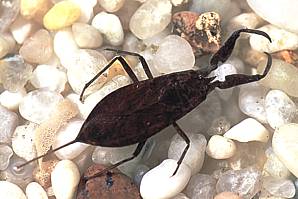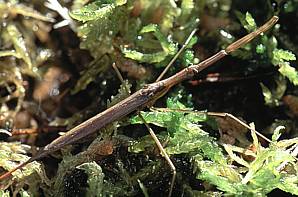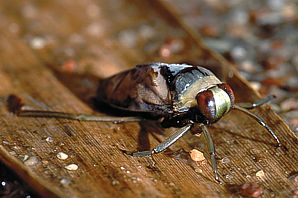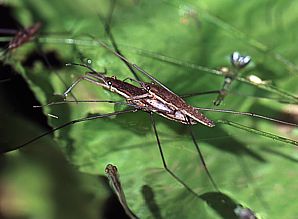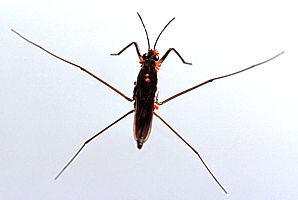|
AQUATIC INSECTS
|
||||||||||||
Text:
|
Heteropterans
THE VARIED-WING BUGS Heteroptera are a group of insects having a characteristic flattened body on the back and abdomen, a stinging-sucking mouth opening and the differentiated construction of wings - the frontal wings are chitinous and membrane-like while the back wings are just membrane-like. In the process of evolution some varied-wing bugs Heteroptera got used to living secondarily in water. Some species of bugs settle the water surface while others live in the water depths. Water bugs deal with the polymorphism of wings. In view of that, the same sort of bugs can have a swift or reduced to some degree wings. Larvae are similar to adult individuals however they do not have the formed wings.
There are 30 species of water bugs in the area of Wigry National Park which constitutes 46% of fauna of these animals in Poland. Most species (19) are connected with the water depths. They include: Nepidae, Corixidae, Notonectidae and Naucoridae.
Waterscorpions Nepidae are represented in the Park area by two species: Nepa cinerea and Ranatra linearis. They mostly live in stagnant and slowly flowing waters. Thanks to the long respiratory tubes being found at the end of the abdomen they can spend some time underwater right under the water surface. The tube protruding over the surface membrane of water enables receiving the atmospherical air. They hunt motionlessly being on the lookout for small animals. The mating takes place in spring. The female lays eggs on the water plants equipped with the thread-like respiratory growths (6-8 for Ranatra linearis and 2 for Nepa cinerea). In May the larvae are hatched having almost no differences as far as adult individuals are concerned (incomplete transformation) - larvae are smaller and possess considerably shorter respiratory tubes. Only the adult individuals spend the winter period.
Lesser water boatmen Corixidae The most numerous group (14) of bugs are Corixidae. They settle different kinds of water reservoirs in the Park. They mainly eat animal food digging the sediments and consuming algae and detritus. They swim with the help of transformed peddle-like back limbs. They can accelerate their body so that they can jump over the water surface and continue flying for some time. When under water they breathe the air accumulated on the body surface among the delicate little hair and under wings. These insects are lighter than water and thus they have to cling their sharp little claws so as not to be pushed over the water surface. When the reserve of air is empty they swim up and take another portion with the help of pretrachea placed on the trunk and abdomen. Some Corixidae males produce characteristic twittering sounds during the mating period. The sound is produced by rubbing the surface of thigh of frontal limb, which is covered with callosities, with the head grooves. The female lays eggs on the surface of water plants when larvae are hatched in early summer. They spend the winter period as adult insects with exception to Micronecta genus.
Water boatmen Notonectidae move on the water with their back bent downwards because their centre of gravity is placed closer to the line of back. They stay under the water surface leaning over the surface membrane with the help of frontal and central limbs. The shins and feet of back legs are hairy - thanks to that they are equipped with a perfect natatorial organ. Having dried their wings they are good aviators. They spend the winter period in eggs or as adult individuals. Larvae are very similar to adults.
Creeping water bugs Naucoridae are represented in the Park by one species - Ilyocoris cimicoides. It lives in all kinds of the reservoirs which are abundant in water vegetation. It breathes the air accumulated on the surface of the body which is covered with delicate little hair. From time to time it swims up and it regenerates the reserve of air by putting the end of abdomen out of the water. Thanks to the hairy natatorial back limbs functioning as paddles it is a perfect swimmer. The female lays eggs which are placed under the skin of water plants by means of a special arranger. It spends the winter period as an adult Naucoridae.
Some species of bugs (11 species living in the Park) are connected with the water surface – they are so-called pleustonial types and they include: Gerridae and Hydrometridae.
Pond skaters Gerridae spend most of their lives on the water surface. They go ashore in winter only. With the exception to the upper side of the body, they are covered with thick short little hair having strong hydrophobic properties (such hair does not absorb water). They move with sliding movements using the surface tension of water. They touch the water surface with the back and central pair of exceptionally long limbs. The frontal pair of limbs is used to seize the trophy - living and dead insects being found on the water surface. In spring and early summer the bugs get into pairs. After several days of mating the female still carries the male on her back. The eggs, single or in packets, are attached to the water plants with a jelly-like secretion. Having hatched the young larva drops to the bottom and swims up after some time. There are 8 species of Gerridae in the Park area and the most common is Gerris lacustris.
Water measurers Hydrometridae live in the shore vegetation of stagnant and slowly flowing waters. They have a long and slender body with a characteristic long and narrow head. They move slowly using the stilts-like legs. Long feelers resemble the additional fourth pair of limbs. The pairs unite early summer and then the female lays eggs several times. Their eggs are very long and they are often attached to the plants protruding over the water surface by the female. They eat water insects and spend the winter period ashore, under stones or in other hideouts.
|
|||||||||||
|
|
|
